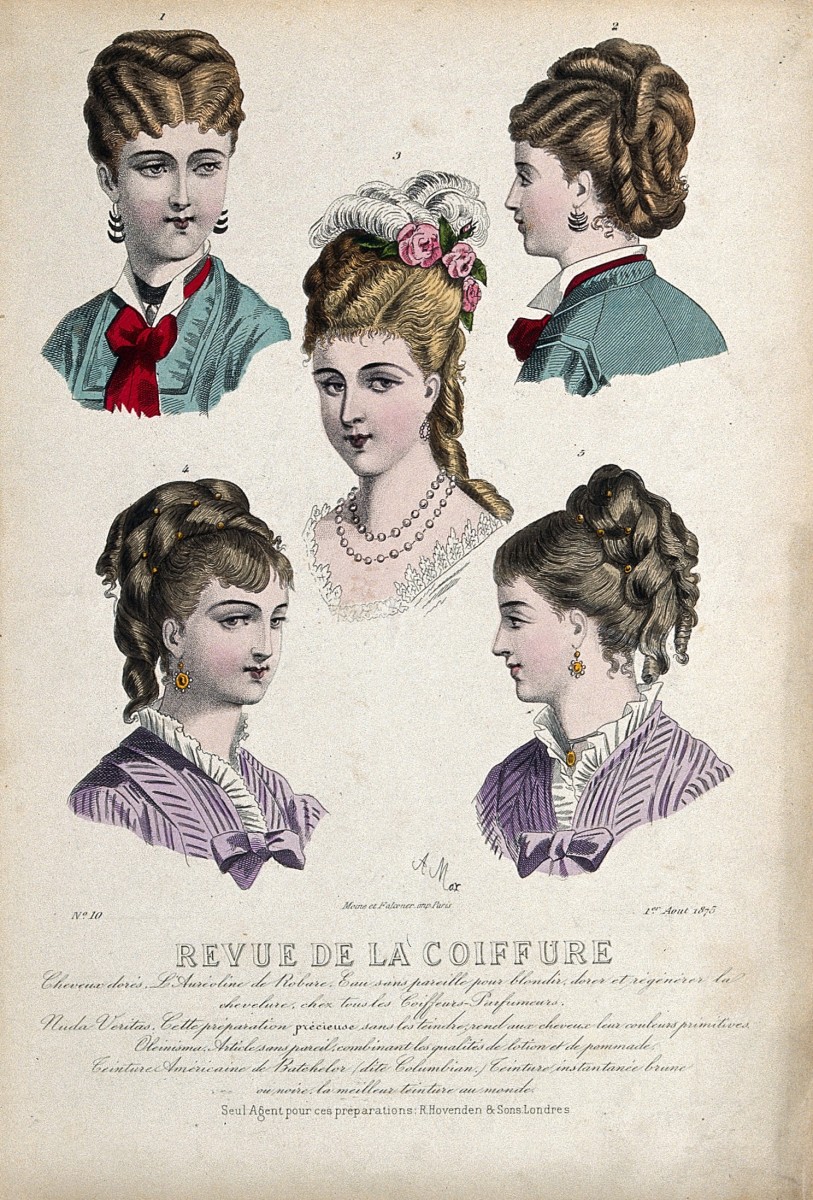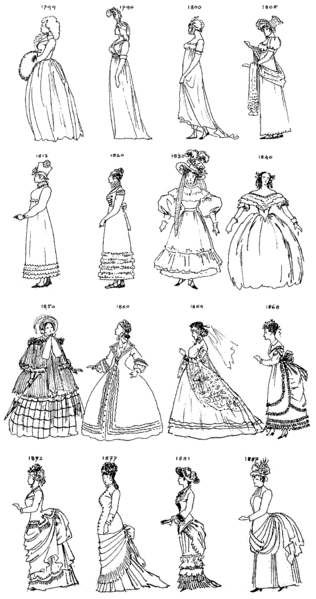The extreme restriction placed on womens bodies through the princess-line corsetry large bustles. Dress skirts and bodices also received more surface decoration marking a move into the exuberant Victorian age.

Working Class Victorian Life Witness2fashion
If one looks for example as navvies working on the railway they are wearing shirts waistcoats and neck ties.

. In 1800 working-class people wore linen underwear men wore woollen outer clothing and women wore cotton linen and woollen dresses. Ruffles and pleated frills are characteristic trimmings of the 1870s. Suits became popular for women.
Fashion in the 1880s in Western and Western-influenced countries is characterized by the return of the bustle. Gone were the elaborate gowns with sweeping trains and gathered over-skirts. Womens fashions of the 1890s epitomized a new kind of woman.
If one looks for example as navvies working on the railway they are wearing shirts waistcoats and neck ties. In the 1970s many pioneer feminists adopted dungarees as a sartorial rejection of fashion and conventional gender roles. Fashionable waists were low and tiny below a full low bust supported by a corset.
By 1850 the cotton linen and woollen trades were fully mechanised in England. The form of the skirt again changed dramatically in the 1880s with new arrangements of folds drapes and pleats and a reappearance of the bustle. Just like their bosses.
1870 fashion plate shows jacket-bodices with draped and trimmed skirts in back. Hand-spinning had largely died out which prevented industrious families from producing their own textiles to reduce costs. Up to 24 cash back Women in the working class wore simpler ready to wear versions of the popular fashions but with cheaper materials and lower quality cloth.
Tight corsets countered and emphasized the large skirts. Work clothes were of course older and shabbier but on Sundays the workers would wear their Sunday best. The bodice and sleeves are lined with ivory linen.
Readers wishing to obtain the book can e-mail the following address. He decade of the 1870s is one of the most complex. Romance was juxtaposed with practicality in sleek new styles.
The long lean line of the late 1870s was replaced by a full curvy silhouette with gradually widening shoulders. Ruffles and pleated frills are characteristic trimmings of the 1870s. Gray figured silk three piece 1870s dress with brown and white woven flower sprays.
Evening gowns were low-cut with short sleeves while daywear had high necklines and long sleeves. In the 60s and 70s fashion was a largely aspirational medium. A number of new womens styles made their way into the fashion world during the 1860s.
The decade was particularly marked by a change in the shape of womens skirts both in the use of gored skirt and in the addition of the oval hoop. Hair was worn in sleek puffy up-dos. Soon by 1873 the train was seen in day dress.
Later when steel cage petticoats came into fashion the skirt was smoother. The front bodice fastens with hooks and has six. What urban working-class men wore in the 1860s.
Women styled their hair with a center part side curls and a bun. 1870s American bathing dress with. Euryalus Sep 2 2013.
Homemade clothing including homemade dressmaking was very common within this class. Both skirts and bodices continued to receive a lot of trim and frill and the styles remained quite exuberant. Western fashion history 1880s.
The former bustle of the 1870s and 1880s morphed into a nonintrusive skirt pad and the overall silhouette simplified. Men in a dyeworks 1860s and 70s. See more ideas about historical fashion historical clothing historical dresses.
Mar 19 2016 - Explore Bec Banhams board Victorian Working ClassLower Class Clothing 1840-1860 followed by 181 people on Pinterest. In the 1970s many pioneer feminists adopted dungarees as a sartorial rejection of fashion and conventional gender roles. Throughout the decade the focus of clothing design was concentrated at the back a continuation of trends that began in the 1870s Tortora 390.
Clothing was designed to. Subcultures as disparate as Hells Angels hippies punks and New Agers have often demonstrated their nonconformism by blending garments from a variety of sources including working clothes. On a different note.
There is a long sleeve bodice an ribbon trimmed overskirt and a fully lined skirt. As more women entered the workforce their wardrobes had to be adapted to the changing roles outside the home. Dresses were decorated with lace ruches and ribbons.
There were certain magazines especially made for people in the working class such as Mabs. The shirtwaist was the new day wear staple. Subcultures as disparate as Hells Angels hippies punks and New Agers have often demonstrated their nonconformism by blending garments from a variety of sources including working clothes.
F ashion in the 1880s was increasingly slender and angular marked by heavy decoration. At the same time clothes were designed for women to wear in the workplace and to accommodate. By 1875 soft polonaise bustle styles were becoming so extreme that the soft fullness began to drop down the back of the garment and form itself into a tiered draped and frilled train.
From 1870 ball gowns always had a train. An hourglass silhouette defined the feminine form and womens clothing lost some of the restrictive aspects. The author has graciously shared with readers of the Victorian Web this passage from the second edition of her Fashion in Costume 1200-2000 2000 published by A C Black Publishers Ltd which retains copyright.
Walking dress of 1870 has a tiered and ruffled skirt back. 1870s womens fashion placed an emphasis on the back of the skirt with long trains and fabric draped up into bustles with an abundance of flounces and ruching. What Victorian Agricultural Workers and Other Countrymen Wore.
That influence is working class culture and without it fashion would not be what it is today. Manchester Operative Factory Worker 1842.

Stitching The Fashions Of The 19th Century Who Dressed The 19th Century Elite

The Bustle Era Women S Fashions Of The 1870s And 1880s Bellatory

The Iconic Women S Fashion Of The Victorian Times

1870 1879 Fashion History Timeline

The Bustle Era Women S Fashions Of The 1870s And 1880s Bellatory

Working Class Victorian Life Witness2fashion

Early 1870s Victorian Life Victorian Photos Victorian London

0 comments
Post a Comment